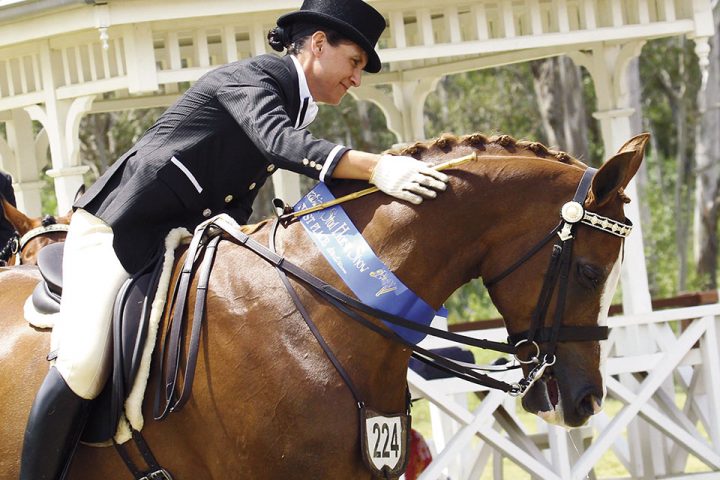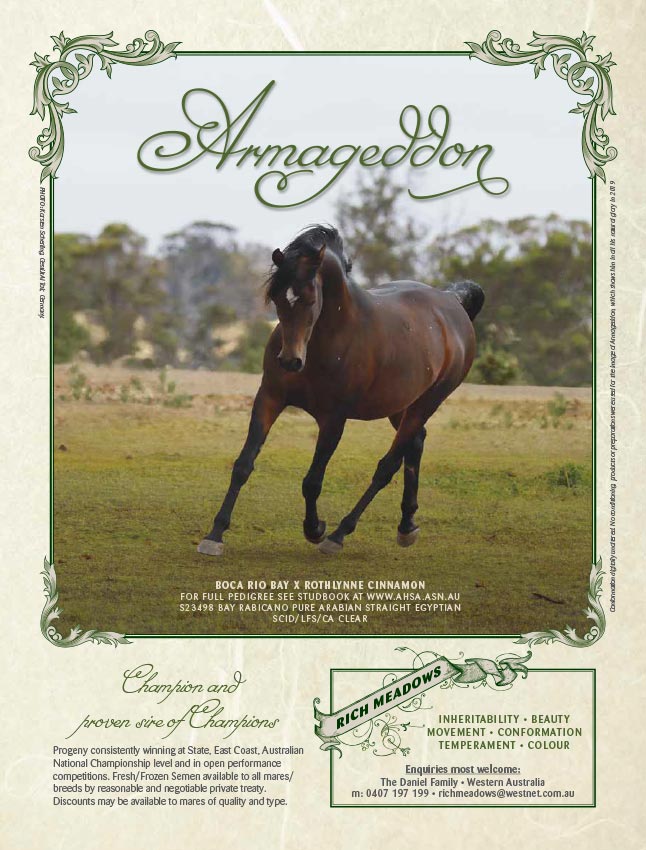Dream Seat or Saddle Fit Nightmare

The Real McCoy
September 3, 2020
Stallion Accumulators
September 3, 2020Dream Seat or Saddle Fit Nightmare

The beautiful complexity of the Arabian back
BY JANE CLOTHIER | BALANCED HORSE SERVICES
In just a few words, here is a lesson in saddle fitting for Arabians: they are often complicated, really complicated. That’s a very generalised statement, so if you have never had any trouble finding a saddle for your horse, please disregard it – there are plenty of exceptions and you are fortunate to own one. However, it remains that there’s a high percentage of complicated backs to saddle than in most other breeds. Take a look online and you’ll find plenty of saddle fitters writing a similar story.
It’s worth taking a closer look at your horse’s back. In my experience, many Arabians have what could be termed a ‘combo back’. That is just my lingo to explain that Arabian horses often have a number of conformation features together that in other breeds would usually be found in different combinations. These all affect saddle fit, being the region from the rear third of the withers to the lumbar, or loins.
What are we looking at here? The Arabian back is, as we all know, shorter, with (frequently) 17 thoracic vertebrae and 5 lumber vertebrae, instead of the usual 18 and 6. Their rib cage is often broad and well rounded, and their wither is either barely there or is mid-height, but long. In either case, at its base, the spine suddenly flattens out and widens into a flatter back. That’s happening bang in the area of the saddle seat. Their shoulders can be long and sweeping, either well-muscled or narrow, and the croup can be high, and sometimes extremely high.
To spell out exactly why having two or three of these features can be complicated: in other breeds, a horse with narrower shoulders and a good wither will often have a narrower rib cage and an ‘A-frame’ shaped back, rather than a flat back. A horse with a high croup will often have a longer back, rather than a short compact one. Arabians are indeed, a breed of their own.
This isn’t a problem for the horse, of course. Arabian horses have strong, magnificently functional bodies that have enabled them to swing through thousands of years and cover endless desert kilometres, and doing so without any apparent effort. The problem is otherwise they’ll end up sitting against the cantle. It helps if they can ride with long stirrups and straight legs, but it is not so easy to adapt a larger seat size to a shorter saddle.
If we add in another feature, a steep upward sweep towards a high croup, then there’s also a good chance that the saddle will bridge. This is when the panels make a strong contact at the front and back, but do not fit close to the horse’s body beneath the seat itself. This will then create excess pressure, and often pain, at the front and the rear of the saddle. This is also an issue with western saddles, which a rather more obvious one and it’s common to all breeds: the horse’s back wasn’t designed to be sat on and certainly wasn’t designed for saddles.

Until relatively recently, saddle designs were quite limited, but there are now many different models and designs on the market. You would think that finding a saddle would be easier – it is, but it’s still a problem-solving exercise.
The first conundrum comes with the relationship between the horse’s back length and the rider size in terms of length of leg and/or their pant size. With a shorter back, the Arabian’s saddle must also be shorter, so that it sits over the stronger rib cage area. If it is longer and adding pressure to the lumbar spine, problems will follow, with the horse hollowing the back and potentially experiencing pain. On the other hand, taller riders need larger seat sizes, so their longer upper leg can be accommodated, as well as being shorter need to have rounded skirts, as a square cornered skirt may dig in uncomfortably at the point of hip. The solution for both this, and to accommodate the nonpetite rider, is to use a saddle with compact panels that are shorter in length than the seat, or at least the cantle. Long panels that extend out behind the cantle are a definite no-no.
The low or medium wither that widens rapidly into the flatter back with a rounded rib cage creates new needs. First, the panels of the saddle need to be wider and flatter for this kind of back. While saddles may accommodate the moderate wither, many aren’t wide enough for the rib cage. If the croup is high, the tree and panels also need to sweep upwards at the back. If the back is fairly flat along the topline, then they need to be straight through the tree and panels.
With the low withered horse with a wide flat back, it is often not enough to simply widen the front of the tree at the points. With synthetic trees in particular, when this happens it becomes more concave through its length, with a stronger dip in the seat area. This is not always a problem, but can lead to a saddle that rocks back and forth. When the rider is aboard, it tilts back, adding pressure to the loins. One solution to this is an English saddle tree design known as a ‘hoop’. Instead of being a more ‘V’-shaped pommel arch, it is more like an inverted ‘U’, allowing greater clearance.
We are not done yet! Add to all this the fact that a round rib cage usually means the ‘girth notch’ is well forward, close to the elbow. The notch is always the highest point beneath the sternum – the girth will always gravitate to this spot. There are two ways to work with this. First, a point strap on the saddle can help to bring the first girth billet forward, which stabilises the saddle. Second, an anatomically shaped girth will help, as the widest part sits in that narrower location. Otherwise, the girth will pull forwards and tilt the saddle, so that the panels again pull down into the loins.
Finally, there is another feature of Arabians that affects saddle fit: the often seen ‘head high’ way of going. While this posture is undoubtedly natural, it can lead to problems for the ridden and saddled horse, given that a head held high will lead to a flattened or hollow back. Once more, this changes the nature of the contact between saddle and the horse’s back, with bridging all the more likely. Fortunately, this is something that can be addressed through training, leading to a lower chance of back pain through saddle fit and weight bearing generally.
As we can see, this ‘combo back’ effect means that we need to think about the shape of the saddle tree along every inch of its length and width, as well as across the front. All too frequently, when we correct one aspect, another often goes wrong. These are truths for any saddle fitting, for any breed, and for all types of saddle. Thankfully, with the market expanding and more breed specific brands and models appearing, the task of finding the correct tack is becoming easier. I am firmly of the view that the more owners understand the nature of their horse’s back, the more chance there is of the horse’s ‘care crew’ getting it right.
For more information please visit www.balancedhorse.com.au































